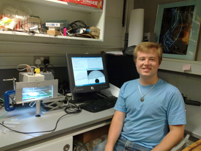
University:
Major:
Site Abroad:
Mentor(s):
Faculty Sponsor(s):
Project Title:
Project Description:
When a granular medium, such as sand, stops after flowing, it does not flatten under gravity but forms a characteristic slope. This slope is called the angle of repose and is typically between 20 and 45 degrees for dry grains. This phenomenon is thought to arise from the frictional nature of the grains. Naively, one therefore may expect that in the absence of friction, the angle of repose would be zero. We test this idea by measuring the angle of repose of wet foam. Wet foam is a packing of bubbles that are nearly spherical. This foam can be thought of as a soft, frictionless, granular matter. While there is viscous dissipation between neighbouring bubbles during flow, there is no static friction, as compared to solid grains. We measured the angle by putting a two-dimensional, disordered wet foam in a rotating drum setup. We initiated the flow by rotating the drum and measured the angle after subsequent relaxation of the bubbles after the rotation was stopped. We kept the foam wet and eliminated drainage by constraining the foam within the capillary length. In addition, we used perfluorohexane gas to reduce coarsening of the bubbles which enabled us to do repeated runs over many hours. The data shows that wet foams do have a non-zero angle of repose and that it varies from 6 to 11 degrees. The polydispersity of the foam appears to be the dominant factor in the variation of the angle.
